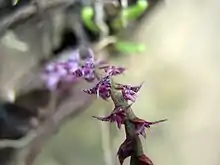Bulbophyllum teretifolium
Bulbophyllum teretifolium is a species of plant in the family Orchidaceae. It is an epiphyte with cylindrical leaves and up to about forty small, white and purplish flowers and is endemic to Cameroon. Its natural habitat is subtropical or tropical, moist montane forests, where it is threatened by habitat loss.[1]
| Bulbophyllum teretifolium | |
|---|---|
 | |
| Scientific classification | |
| Kingdom: | Plantae |
| Clade: | Tracheophytes |
| Clade: | Angiosperms |
| Clade: | Monocots |
| Order: | Asparagales |
| Family: | Orchidaceae |
| Subfamily: | Epidendroideae |
| Genus: | Bulbophyllum |
| Species: | B. teretifolium |
| Binomial name | |
| Bulbophyllum teretifolium | |
| Synonyms[2] | |
|
Bulbophyllum kupense P.J.Cribb & B.J.Pollard | |
Description
Bulbophyllum teretifolium is an epiphytic herb with pseudobulbs 26–33 mm (1–1 in) long and 4–6 mm (0.2–0.2 in) wide. Unique to the genus, the leaves are cylindrical in shape, 120–225 mm (5–9 in) long and about 2 mm (0.08 in) wide. Between 19 and 37 white and purplish pink flowers are borne on a thin flowering stem 55–105 mm (2–4 in) long, each flower on a pedicel (including the ovary) 1.5–2 mm (0.06–0.08 in) long. The dorsal sepal is oval, 3.5–4 mm (0.1–0.2 in) long, about 2 mm (0.08 in) long and slightly warty, the lateral sepals 4–4.5 mm (0.2–0.2 in) long and about 2 mm (0.08 in) wide. The petals are about 1.5 mm (0.06 in) long and less than 0.5 mm (0.02 in) wide. The labellum is about 2 mm (0.08 in) long and 1.0–1.5 mm (0.04–0.06 in) long and has three lobes.[3]
Taxonomy and naming
Bulbophyllum teretifolium was first formally described in 1905 by Rudolf Schlechter and the description was published in Botanische Jahrbücher für Systematik, Pflanzengeschichte und Pflanzengeographie.[2][4] The specific epithet (teretifolium) is from derived from the Latin words teres meaning "rounded"[5]: 249 and folium meaning "a leaf".[5]: 123
In 2004, Phillip Cribb and Benedict John Pollard reported on the discovery of a single epiphyte that Pollard had discovered in 2002 on one small, cultivated mango tree (Mangifera indica), in a private garden in Nyasoso (at elev. 830 m), Mount Kupe. They gave it the name Bulbophyllum kupense.[6] It is the only one ever recorded, and it is still living. However, it is highly probable that this is not the only example of this species, which likely occurs somewhere in the forests on and around Mount Kupe.[1] A plan by the interested parties (Pollard, Cribb and others) to propagate a small part of the plant that was removed, is now underway. Pollard had observed that the garden that surrounds the plant's host has been fenced, affording it better-than-nothing protection.[1] Bulbophyllum kupense is regarded as a synonym of B. teretifolium by the World Checklist of Selected Plant Families.[2]
Distribution and habitat
This orchid is only known from near Yaoundé, the capital city of Cameroon where it grows on the side of a hill.[3]
Conservation
Bulbophyllum teretifolium grows in forest threatened by deforestation, hunting and clearing for agriculture but with no conservation status. As B. kupense it is classed as "critically endangered" by the International Union for Conservation of Nature.[1]
References
- "Bulbophyllum kupense in IUCN 2009". IUCN Red List of Threatened Species Vers. 2009.1. Assessors: Pollard, B.J.; Darbyshire, I. / Evaluators: Zapfack, L.; Cribb, P.J. (Orchid Red List Authority). International Union for Conservation of Nature and Natural Resources. 2004. Retrieved November 20, 2009.
{{cite web}}: CS1 maint: others (link) - "Bulbophyllum teretifolium". World Checklist of Selected Plant Families (WCSP). Royal Botanic Gardens, Kew.
- Droissart, Vincent; Stevart, Tariq (2004). "Note écologique sur Bulbophyllum teretifolium Schltr., une Orchidaceae endémique du Cameroun" (PDF). Taxonomania. 13. Retrieved 1 January 2019.
- Schlechter, Rudolf (1907). "Orchidaceae africanae, imprimis Africae occidentalis". Botanische Jahrbücher für Systematik, Pflanzengeschichte und Pflanzengeographie. 38: 18. Retrieved 31 December 2018.
- Brown, Roland Wilbur (1956). The Composition of Scientific Words. Washington, D.C.: Smithsonian Institution Press.
- Cribb, Phillip J.; Pollard, Benedict John (2004). "Bulbophyllum kupense P. J. Cribb & B. J. Pollard, an Unusual New Orchid from Western Cameroon". Kew Bulletin. 59 (1): 137–139. doi:10.2307/4111087. JSTOR 4111087.
